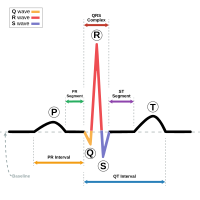
Photo from wikipedia
BACKGROUND AND OBJECTIVES Most deep-learning-related methodologies for electrocardiogram (ECG) classification are focused on finding an optimal deep-learning architecture to improve classification performance. However, in this study, we proposed a methodology… Click to show full abstract
BACKGROUND AND OBJECTIVES Most deep-learning-related methodologies for electrocardiogram (ECG) classification are focused on finding an optimal deep-learning architecture to improve classification performance. However, in this study, we proposed a methodology for fusion of various single-lead ECG data as training data in the single-lead ECG classification problem. METHODS We used a squeeze-and-excitation residual network (SE-ResNet) with 152 layers as the baseline model. We compared the performance of a 152-layer SE-ResNet trained on ECG signals from various leads of a standard 12-lead ECG system to that of a 152-layer SE-ResNet trained on only single-lead ECG data with the same lead information as the test set. The experiments were performed using five different types of rhythm-type single-lead ECG data obtained from Konkuk University Hospital in South Korea. RESULTS Experiment results based on the combination from the relationship experiments of the leads showed that lead -aVR or II revealed the best classification performance. In case of -aVR, this model achieved a high F1 score for normal (98.7%), AF (98.2%), APC (95.1%), and VPC (97.4%), indicating its potential for practical use in the medical field. CONCLUSION We concluded that the 152-layer SE-ResNet trained by fusion of single-lead ECGs had better classification performance than the 152-layer SE-ResNet trained on only single-lead ECG data, regardless of the single-lead ECG signal type. We also found that the best performance directions for single-lead ECG classification are Lead -aVR and II.
Journal Title: Computer methods and programs in biomedicine
Year Published: 2022
Link to full text (if available)
Share on Social Media: Sign Up to like & get
recommendations!